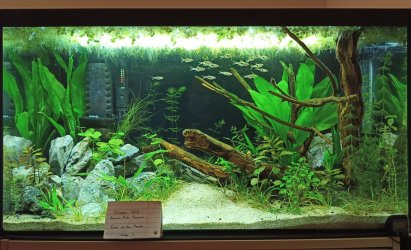For simplicity sake, in this post I'll be referring to trigonostigma hengeli as "the rasboras".
Hello!I was hoping that there might be some of you who have kept this fish recently or in the past. I'm really keen to hear your opinions and experiences in keeping them, in community tanks but single species tanks too.
My rasboras have been in the tank now for 34 days to be precise. They still "run for the hills" at any slight movement. When everything is still, they'll come out straight away and seem very happy. If I turn my head, stand up or do anything in their line of sight, they hide.
I'm wondering if there will ever be a point where I can walk past the tank, for example, and not frighten them back to what I have now dubbed "the emotional support corner".
The water parameters are perfect, 14 in the group and plenty of plant cover (including a blanket of floating plants.) So I'm trying to figure out if I can do anything to help.
I've read a little bit about dither fish, introducing more easy going and less skittish fish to help the rasboras relax and feel more comfortable. Dithers are used for aggression too but in this context that wouldn't be the case. Unfortunately I don't have tonnes of options if I were to try a dither fish, I don't think my tank is suitable for most or at least that is the impression I have.
I have a high PH at 7.8-ish, and my dodgy test strip says I have these water hardness parameters:
(German Degrees): GH 4.2, KH 2.3
I am not 100% confident in the reliability of the test strips, for the hardness numbers I have.
I'm going to get a proper liquid hardness test soon, and I'm away soon (23rd to the 27th of October).
So to conclude this post, does anyone have experience with these fish? Are they normally this skittish, and should I try to figure out some tank mates to help with said skittishness? I don't know, but maybe this is just natural behaviour for them



